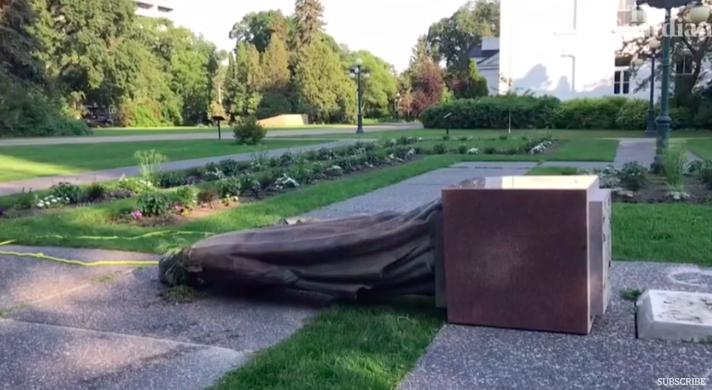
Two royal statues in Winnipeg, Manitoba have been torn down by protestors. Protestors participating in a march to raise awareness for atrocities committed against First Nations, Métis, and Inuit peoples toppled the statues on 1 July.
With the discovery of more and more unmarked graves at residential school sites, 1 July was quite different this year. Normally marked by Canada Day celebrations, many Canadians recognised that it should be a solemn day of retrospect for centuries of suffering that Indigenous people have felt at the hands of European settlers. Many Canada Day celebrations were cancelled, and people were encouraged to spend what they would have spent on fireworks by donating to funds like the Indian Residential School Survivors Society.
There were two separate marches in Winnipeg, with thousands participating. One group started at the Canadian Museum for Human Right, and marched for “No Pride in Genocide”, with residential school survivors sharing their stories and why recognition and reconciliation is so important. A second march, “Every Child Matters” started at the intersection of Portage Avenue and Main Street, and marched to the Manitoba Legislative Assembly.
When protestors ended at the Legislative building, many started covering the statue in red painted handprints, symbolic of all of the children who died and have been lost to residential schools. Approximately, 15 people then tied ropes around the statue and pulled it down while people chanted “No Pride in Genocide”. Some protestors then posed with the statue.
One man was arrested, but it is unclear if he was involved with the statue being pulled down, or was angry with those who did it.
A smaller statue of Queen Elizabeth II at Government House- the home of the Lieutenant Governor General- was also pulled down. The Queen and The Duke of Edinburgh unveiled the statue on their last visit to Winnipeg in 2010.
Many sources are reporting that the residential school system was ended in the 1970s; however, the last residential school in Canada did not close until 1996. Residential schools were run by the government, the Catholic Church, and the Anglican Church beginning in the 1870s. It is thought that over 150,000 children were forced into these schools, where they were forbidden from speaking their own languages and celebrating their own culture and suffered from malnutrition, physical, mental, and sexual abuse, with thousands dying. Many of these deaths were never recorded, but were buried in mass graves at the school.
Canadians are increasingly questioning their relationship with the Crown, largely in part to the lasting impact of colonisation.
The Crown has a complex role in Canada, particularly in Indigenous history and affairs. The treaties that First Nations, Métis, and Inuit groups signed were signed directly with the Crown, not the government. In some Indigenous communities, the monarch is still held in a place of reverence. However, all enforcement and enactment of the treaties were left to the government.

